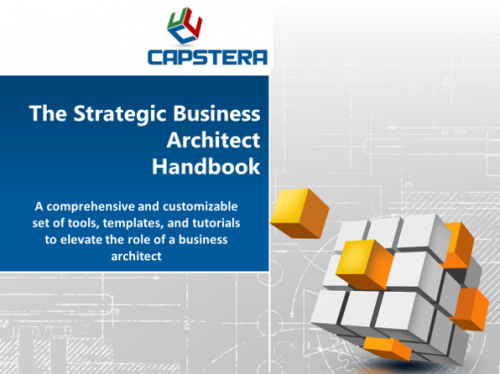
How to Make a Compelling Business Architecture Business Case?
If you are trying to establish a new practice for business architecture and business capability mapping in your organization, you will need to make a compelling business architecture business case. There is a famous saying, “One cannot cost justify architecture”, and while it may partially hold true in making a business architecture business case, there is a need to show real and achievable value. It may not all be quantitative but could be based predominantly on a qualitative business case for justifying business architecture.
Here are 5 simple steps that will stand you in good stead in selling the concept of business architecture and business capability modeling.
-

Enterprise Business Architecture Starter Package
5 Steps to Make a Business Architecture Business Case:
Demonstrate Value by initially applying business architecture and capability mapping concepts to high-impact areas and transformation programs. Providing specific and actionable approaches and leveraging a simplified framework and practical methodology to realize immediate value should be a key consideration.
Link Funding to Capabilities rather than projects to instill the discipline of long-term capability-based thinking. Funding capabilities will avoid two different projects from building similar capabilities. This will lead to cost avoidance and accelerate time to market.
Mandating that all projects above a certain threshold need to leverage the foundational building blocks of business architecture and capability modeling will jumpstart the initiative.
Executive Buy-In for the concept of business architecture and business capability model should be paramount. Executive support in word and deed will go a long way in cementing the business architecture and capability modeling discipline and will allow for building a solid foundation and long-term rewards
Conduct Training and Development to deliver “hands-on” practical sessions on fundamentals of business architecture and how to do capability mapping. In addition, hands-on working sessions on applying capability mapping to real business needs will deliver immense value. A change management exercise may also be warranted.
Sample Business Architecture Business Case
Note: The Business Architecture Business Case is a template with sample content to get you started. Please tailor the business case contents to your company’s unique situation and needs.
Business Case For Business Architecture
Executive Summary
As a mid-sized global company, we face growing complexities and challenges that demand effective business decision-making and efficient resource utilization. To address this, we propose implementing a Business Architecture framework to provide a holistic perspective of our organization, bridge the execution-to-strategy gap, and streamline IT enablement. This business case will cover the drivers, scope, financial metrics, analysis, costs, benefits, risks, and strategic options for implementing Business Architecture within our company.
-

Enterprise Business Architecture Starter Package
Project Context
Our company has grown rapidly in recent years, with an increasingly complex business environment due to globalization, mergers, and acquisitions. As a result, our existing business processes, IT systems, and management practices have become fragmented and misaligned. Implementing Business Architecture will help us align our organization’s structure, processes, and IT systems with our strategic objectives while ensuring optimal resource allocation and improving our overall agility.
Business Drivers
- Accelerated global growth
- Need for strategic alignment across business units
- Enhanced agility to respond to changing market conditions
- Improved IT efficiency and effectiveness
- Simplification and standardization of business processes
- Regulatory compliance and risk mitigation
Scope
The project scope includes the following elements:
- Developing a Business Architecture framework
- Aligning business processes with strategic objectives
- Streamlining IT enablement
- Training key stakeholders and staff
- Monitoring and continuous improvement
Financial Metrics
The project’s financial metrics include the following:
- Cost savings from reduced IT expenditures
- Increased revenue from improved business processes
- Reduction in operational costs
- Return on Investment (ROI) calculations
Analysis
Our analysis will focus on the following:
- Assessing current processes, IT systems, and management practices
- Identifying areas of improvement and alignment with strategic objectives
- Evaluating potential risks, costs, and benefits
- Determining strategic options and financial metrics
Assumptions
Key assumptions for this project include the following:
- Management commitment and support
- Adequate resources for successful implementation
- Ongoing support for continuous improvement
- Willingness to adapt and adopt new practices
Costs
The estimated costs for the project are as follows:
- External consultancy fees: $150,000
- Training and change management: $50,000
- Software and infrastructure upgrades: $200,000
- Internal resource allocation: $100,000
- Total project cost: $500,000
Benefits
We expect the implementation of Business Architecture to yield the following benefits:
- Streamlined and standardized business processes
- Improved decision-making through increased visibility and insights
- Enhanced IT efficiency and effectiveness
- Greater agility to respond to changing market conditions
- Cost savings from reduced IT expenditures
- Increased revenue from improved business processes
Risks
Key risks associated with the project include:
- Resistance to change among employees
- Inadequate management support or commitment
- Insufficient resources for successful implementation
- Inability to achieve expected benefits
- Strategic Options
The strategic options available to address the project objectives include the following:
- Implementing Business Architecture in-house
- Engaging external consultants for implementation
- Adopting an incremental approach to implementation
- Net Cash Flow and ROI
Projected net cash flow over three years:
- Year 1: -$500,000 (project costs)
- Year 2: $200,000 (benefits)
- Year 3: $400,000 (benefits)
Cumulative net cash flow: $100,000 ROI: 20%
-

Enterprise Business Architecture Starter Package
Recommendation
Our analysis recommends implementing a Business Architecture framework in-house, supported by external consultants as needed. This approach will provide the greatest long-term benefits and return on investment while enabling us to build internal capabilities and maintain control over the process.
Next Steps
To move forward with the implementation of Business Architecture, we propose the following next steps:
- Obtain management approval and secure funding for the project.
- Identify and assemble a project team, including internal stakeholders and external consultants as needed.
- Develop a detailed project plan, including scope, timelines, and milestones.
- Initiate a comprehensive assessment of current processes, IT systems, and management practices to identify areas of improvement and alignment with strategic objectives.
- Design the Business Architecture framework, ensuring alignment with our company’s strategic goals.
- Implement the framework, focusing on process improvements, IT enablement, and alignment with strategic objectives.
- Conduct training and change management activities to ensure stakeholder buy-in and support for the new framework.
- Monitor and measure the effectiveness of the new Business Architecture, adjusting as needed to optimize performance and achieve desired benefits.
- Foster a culture of continuous improvement to ensure the ongoing success of the Business Architecture framework.
By following these steps, our company will be well-positioned to achieve a holistic business perspective, bridge the execution-to-strategy gap, and streamline IT enablement. This, in turn, will enhance our competitiveness in the global market and drive long-term success.
Have you recently made a business architecture business case? How did it go? Let us know. If you need help in preparing a business architecture business case, please contact Capstera business architecture experts.
What are others saying?
- Cutter Consortium
- Business Architecture Institute





